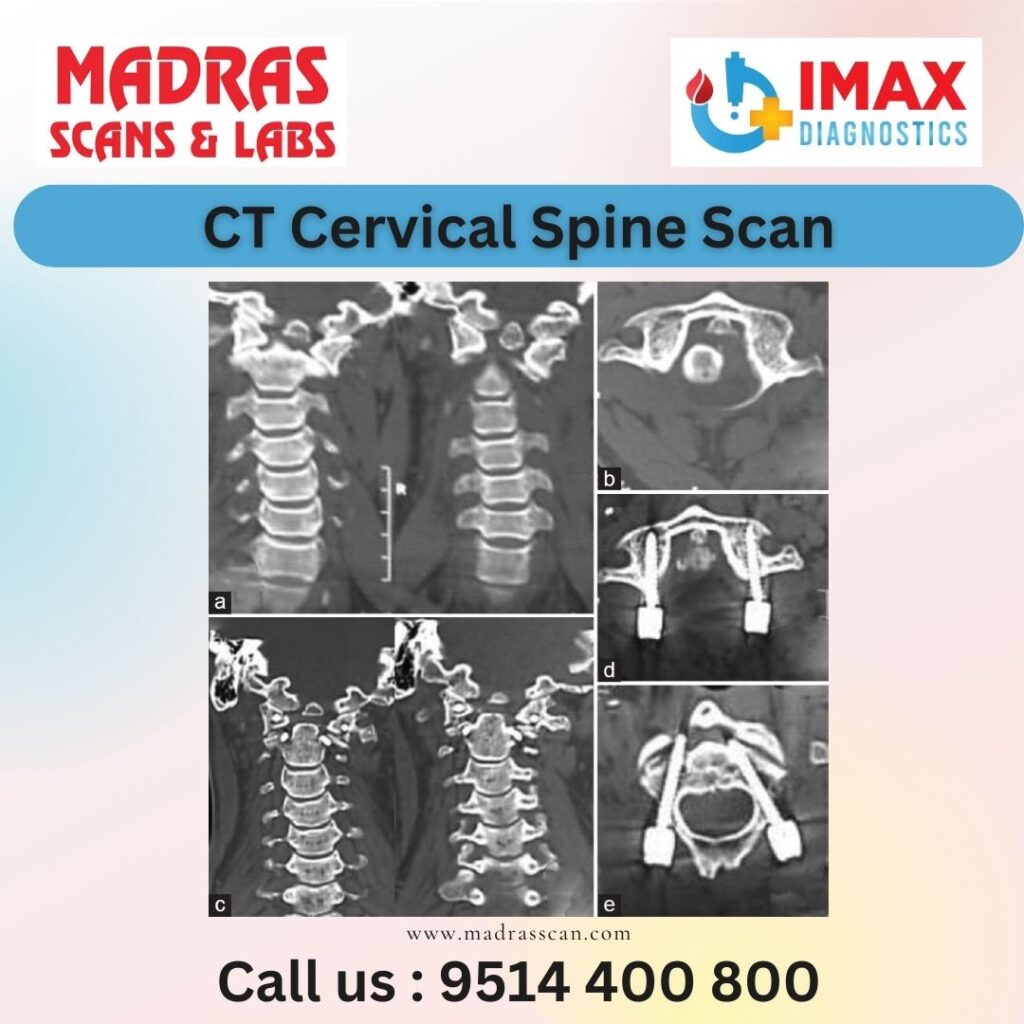Low cost CT Cervical Spine Scan in Chennai

A CT (computed tomography) scan of the cervical spine is a medical imaging procedure that uses X-rays and computer technology to create detailed cross-sectional images of the cervical (neck) region of the spine. The cervical spine consists of seven vertebrae (C1 to C7) and is crucial for supporting the head and facilitating various movements of the neck.
Here is some information about CT cervical spine scans:
Purpose:
Diagnostic Evaluation: CT scans of the cervical spine are often performed to assess and diagnose conditions such as fractures, dislocations, or injuries resulting from trauma.
Degenerative Changes: The scan can help in identifying degenerative changes such as arthritis, disc herniation, or spinal stenosis.
Tumor Detection: It can be used to detect tumors or abnormalities in the cervical spine.
Infection: CT scans can assist in identifying infections affecting the spine.
.
A CT (computed tomography) scan of the cervical spine is a medical imaging procedure that uses X-rays and computer technology to create detailed cross-sectional images of the cervical (neck) region of the spine. The cervical spine consists of seven vertebrae (C1 to C7) and is crucial for supporting the head and facilitating various movements of the neck.
Here is some information about CT cervical spine scans:
Purpose:
Diagnostic Evaluation: CT scans of the cervical spine are often performed to assess and diagnose conditions such as fractures, dislocations, or injuries resulting from trauma.
Degenerative Changes: The scan can help in identifying degenerative changes such as arthritis, disc herniation, or spinal stenosis.
Tumor Detection: It can be used to detect tumors or abnormalities in the cervical spine.
Infection: CT scans can assist in identifying infections affecting the spine.
Procedure:
Preparation: Depending on the medical facility’s protocol, you may be asked to wear a hospital gown and remove any metal objects or jewelry that could interfere with the imaging.
Contrast Medium: In some cases, a contrast medium (a dye) may be used to enhance the visibility of certain structures, such as blood vessels or abnormal tissues. This is usually administered through an intravenous (IV) line.
Positioning: You will be positioned on the CT scanning table, and the table will move slowly through the CT scanner.
Scanning: The CT scanner uses X-rays to create detailed cross-sectional images of the cervical spine. Multiple images will be taken from different angles.
Duration: The procedure is relatively quick, typically taking only a few minutes.
Risks:
Radiation Exposure: CT scans involve exposure to ionizing radiation. The amount is generally considered safe for diagnostic purposes, but the risk-benefit ratio is considered, especially in sensitive populations.
Contrast Medium Risks: If contrast dye is used, there is a slight risk of an allergic reaction or kidney issues, particularly in individuals with pre-existing kidney problems.
Results: After the CT scan, a radiologist will analyze the images and provide a report to your healthcare provider. The results will help guide further diagnosis and treatment.
For a doing painless CT Cervical Spine Scan in Chennai, consider Madras Scans & Labs as your go-to destination. It is the most trusted Scan center in Chennai with its exceptional and secure diagnostic services at an affordable pricing system.
Give us a quick call at 9514400800 or visit us at https://www.madrasscan.in to know more about other scans and our attractive price package.
